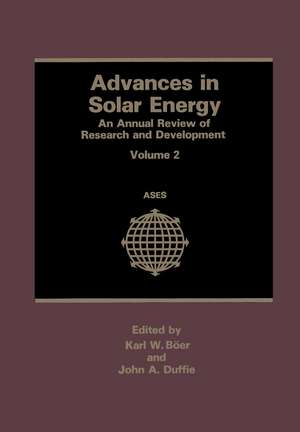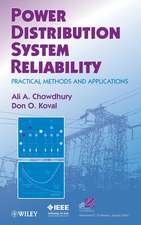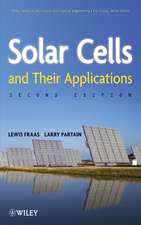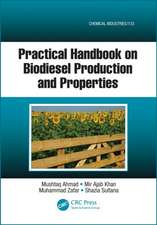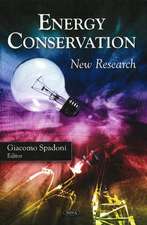Advances in Solar Energy: An Annual Review of Research and Development Volume 2
Autor Karl W. Boer, John A. Duffieen Limba Engleză Paperback – 9 mai 2012
Preț: 654.43 lei
Preț vechi: 769.92 lei
-15% Nou
Puncte Express: 982
Preț estimativ în valută:
125.25€ • 130.26$ • 104.81£
125.25€ • 130.26$ • 104.81£
Carte tipărită la comandă
Livrare economică 15-29 martie
Preluare comenzi: 021 569.72.76
Specificații
ISBN-13: 9781461399537
ISBN-10: 146139953X
Pagini: 512
Ilustrații: XXII, 488 p. 70 illus.
Dimensiuni: 170 x 244 x 27 mm
Greutate: 0.81 kg
Ediția:Softcover reprint of the original 1st ed. 1985
Editura: Springer Us
Colecția Springer
Locul publicării:New York, NY, United States
ISBN-10: 146139953X
Pagini: 512
Ilustrații: XXII, 488 p. 70 illus.
Dimensiuni: 170 x 244 x 27 mm
Greutate: 0.81 kg
Ediția:Softcover reprint of the original 1st ed. 1985
Editura: Springer Us
Colecția Springer
Locul publicării:New York, NY, United States
Public țintă
ResearchCuprins
1 The Measurement of Solar Radiation.- 1.1 Abstract.- 1.2 Characteristics of Pyranometers.- 1.3 General Features of a Pyranometer.- 1.4 Pyranometers.- 1.5 Pyrheliometers.- Appendix 1.1 Historical Perspectives.- References.- 2 Environmental Requirements for Anaerobic Digestion of Biomass.- 2.1 Abstract.- 2.2 Introduction.- 2.3 Microbiology of Methanogens.- 2.4 Nutrient Requirements.- 2.5 Toxicity Response.- 2.6 Alkalinity.- 2.7 Modeling of the Anaerobic Digestion Process.- 2.8 Design Prerequisites.- 2.9 Future Directions.- References.- 3 Principles and Technology of Biomass Gasification.- 3.1 Abstract.- 3.2 Introduction.- 3.3 Gasifier Technology.- 3.4 Principles of Gasification.- 3.5 Conclusions.- 3.6 Acknowledgments.- Appendix 3.1 Units.- References.- 4 Biomass Pyrolysis: A Review of the Literature Part 2—Lignocellulose Pyrolysis.- 4.1 Abstract.- 4.2 Introduction.- 4.3 Pyrolysis of Carbohydrates.- 4.4 Pyrolysis of Lignin.- 4.5 Pyrolysis of Lignocellulosic Materials.- 4.6 Commercial Development.- 4.7 Conclusions.- 4.8 Acknowledgments.- 4.9 Notation.- References.- 5 Thermal Comfort and Passive Design.- 5.1 Historical Notes.- 5.2 Physiological Basis.- 5.3 Summary.- 5.4 Empirical Studies.- 5.5 Analytical Work.- 5.6 The Bioclimatic Chart.- 5.7 Variability of Comfort.- 5.8 Psychological Extensions.- 5.9 Consequences.- 5.10 Behavioral and Clothing Differences.- 5.11 Acclimatization and Habit.- 5.12 Passive Heating Systems and Comfort.- 5.13 Summary.- 5.14 References.- 6 Earth Contact Buildings: Applications, Thermal Analysis and Energy Benefits.- 6.1 Abstract.- 6.2 Earth Contact Structures and Their Applicability.- 6.3 The General Advantages of Earth Contact Structures.- 6.4 Potential Benefits Related to Energy Conservation.- 6.5 Potential Limitations Related to EnergyConservation.- 6.6 Application of Earth Contact Systems.- 6.7 Thermal Analysis of Earth Contact Buildings.- 6.8 Examples of Current Earth Contact Analysis.- 6.9 Investigations Using Computer Techniques.- 6.10 Example of a Detailed Computer Analysis.- 6.11 Future Research.- 6.12 Energy Performance Analysis for Components of Small Earth Contact Structures.- 6.13 General Description of Parametric Studies.- 6.14 Results and Highlights of Parametric Studies.- 6.15 Limitations of Parametric Studies.- 6.16 Preliminary Conclusions.- 6.17 References.- 7 Testing Solar Collectors.- 7.1 Abstract.- 7.2 Introduction.- 7.3 Basic Equations Governing the Thermal Performance of Solar Collectors.- 7.4 Testing Solar Collectors under Clear-Sky, Full-Irradiance Conditions.- 7.5 Testing Solar Collectors under Zero-Irradiance Conditions.- 7.6 Considerations in Testing Air Collectors.- 7.7 Calculating All-Day Collector Performance.- 7.8 Nomenclature.- References.- 8 Concentrating Solar Collectors.- 8.1 Abstract.- 8.2 Introduction.- 8.3 Nontracking Concentrators.- 8.4 Tracking Concentrators.- 8.5 Performance of Concentrating Collectors.- 8.6 Practical Considerations.- 8.7 Summary.- 8.8 References.
